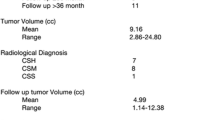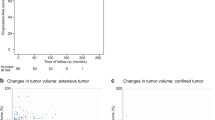Abstract
Background
Considering the proximity to cranial nerves from II to VI and the internal carotid artery microsurgery for cavernous sinus meningioma (CSM) has its limits of complete resection, with high potential tumor recurrences, cranial nerve and vascular morbidity. Gamma Knife surgery (GKS) is an advanced modality as primary treatment for patients harboring symptomatic benign confined CSM as well as adjuvant therapy to postoperative residual tumor giving a high rate of tumor control, stabilizing or even improving clinical condition with low morbidity.
Materials and methods
The aim of this study is to evaluate the safety and efficacy of GKS used in the management of 62 patients with symptomatic benign confined CSM < 3 cm in maximum diameters treated at the International Medical Centre (IMC), Cairo, Egypt, from 2005 to end of 2012, with mean follow-up period of 36 months (range, 24–96 months) by reviewing their clinical and radiological data. For 51 patients GKS was performed as a primary treatment. The diagnosis was based on typical clinical and imaging findings and in 11 patients GKS was used as adjuvant to post-operative tumor residual with histological confirmation.
Results
There were 43 females and 19 males. The median age at the time of treatment was 48 years. The mean tumor volume was 5.7 cc, the mean tumor marginal radiation dose was 14.4 Gy, the mean isodose line was 38 %, and the mean tumor coverage was 94.4 %. The optic pathway received < 8 Gy and the brain stem < 10 Gy. At most recent follow-up, 57 patients (92 %) had stable or improved cranial nerve deficits. Post-GKS cranial nerve complications were detected in five patients (8 %). Tumor volume was controlled in 60 patients (96 %) at most recent follow-up MRI; 12 patients had a reduction in tumor size and 42 had stable tumor size, while tumor size progression was detected in two patients. The tumor progression-free survival at 3 and 5 years in 40 patients who completed at least 5 years of follow-up was 95 %.
Conclusions
Gamma Knife surgery is a safe and effective option for the treatment of cavernous sinus meningioma not only as an adjuvant to surgery but also as an alternative to surgical removal in tumors confined mainly to the cavernous sinus.


Similar content being viewed by others
Abbreviations
- GKS:
-
Gamma Knife surgery
- CSM:
-
Cavernous sinus meningioma
- SRS:
-
Stereotactic radiosurgery
- WHO:
-
World Health Organization
References
Iwai Y, Yamanaka K, Ishiguro T (2003) Gamma Knife radiosurgery for the treatment of cavernous sinus meningiomas. Neurosurgery 52:517–524
Perry A, Scheithauer BW, Stafford SL, Lohse CM, Wollan PC (1999) “Malignancy” in meningiomas: a clinicopathologic study of 116 patients, with grading implications. Cancer 85:2046–2056
Pollock BE, Stafford SL, Link MJ, Garces YI, Foote RL (2013) Single-fraction radiosurgery of benign cavernous sinus meningiomas. J Neurosurg 119:675–682
Sughrue ME, Rutkowski MJ, Aranda D, Barani IJ, McDermott MW, Parsa AT (2010) Factors affecting outcome following treatment of patients with cavernous sinus meningiomas. J Neurosurg 113:1087–1092
Yang SY, Park CK, Park SH, Kim DG, Chung YS, Jung HW (2008) Atypical and anaplastic meningiomas: prognostic implications of clinicopathological features. J Neurol Neurosurg Psychiatry 79:574–580
De Jesus O, Sekhar LN, Parikh HK, Wright DC, Wagner DP (1996) Long-term follow-up of patients with meningiomas involving the cavernous sinus: recurrence, progression, and quality of life. Neurosurgery 39:915–920
Hayashi M, Chernov M, Tamura N, Tamura M, Horiba A, Konishi Y, Okada Y, Muragaki Y, Iseki H, Takakura K (2012) Gamma Knife radiosurgery for benign cavernous sinus tumors: treatment concept and outcomes in 120 cases. Neurol Med Chir (Tokyo) 52(10):714–23
Lee JY, Niranjan A, McInerney J, Kondziolka D, Flickinger JC, Lunsford LD (2002) Stereotactic radiosurgery providing long-term tumor control of cavernous sinus meningiomas. J Neurosurg 97:65–72
Couldwell WT, Kan P, Liu JK, Apfelbaum RI (2006) Decompression of cavernous sinus meningioma for preservation and improvement of cranial nerve function. J Neurosurg 105:148–152
Metellus P, Regis J, Muracciole X, Fuentes S, Dufour H, Nanni I, Chinot LO, Martin M, Grisoli F (2005) Evaluation of fractionated radiotherapy and Gamma Knife radiosurgery in cavernous sinus meningiomas: treatment strategy. Neurosurgery 57:873–886
Hasegawa T, Kida Y, Yoshimoto M, Koike J, Iizuka H, Ishii D (2007) Long-term outcomes of Gamma Knife surgery for cavernous sinus meningioma. J Neurosurg 107:745–751
Roche PH, Régis J, Dufour H, Fournier HD, Delsanti C, Pellet W, Grisoli F, Peragut JC (2000) Gamma Knife radiosurgery in the management of cavernous sinus meningiomas. J Neurosurg 93(Suppl 3):68–73
Mathiesen T, Lindquist C, Kihlstrom L, Karlsson B (1996) Recurrence of cranial base meningiomas. Neurosurgery 39:2–9
Kano H, Park K, Iyer A, Niranjan A, Flickinger JC, Kondziolka D, Lunsford LD (2012) 184 cranial nerve function before and after stereotactic radiosurgery for cavernous sinus meningiomas: a twenty-three year assessment. Neurosurgery 71:571–572
Leber KA, Bergloff J, Pendl G (1998) Dose-response tolerance of the visual pathways and cranial nerves of the cavernous sinus to stereotactic radiosurgery. J Neurosurg 88:43–50
Nicolato A, Foroni R, Alessandrini F, Bricolo A, Gerosa M (2002) Radiosurgical treatment of cavernous sinus meningiomas: experience with 122 treated patients. Neurosurgery 51:1153–1159
Maruyama K, Shin M, Kurita H, Kawahara N, Morita A, Kirino T (2004) Proposed treatment strategy for cavernous sinus meningiomas: a prospective study. Neurosurgery 55:1068–1075
Competing Interests
The authors declare that they have no competing interests, and certify that they have no affiliations with or involvement in any organization or entity with any financial interest (such as honoraria; educational grants; participation in speakers’ bureaus; membership, employment, consultancies, stock ownership, or other equity interest; and expert testimony or patent-licensing arrangements), or non-financial interest (such as personal or professional relationships, affiliations, knowledge or beliefs) in the subject matter or materials discussed in this manuscript. We declare that this is an original article and it was never published whole or in part or submitted elsewhere for review.
Author’s contributions
Raef Farouk Ahmed Hafez conceived, prepared, and reviewed the manuscript.
Magad S. Morgan participated in the design of the study.
Osama M. Fahmy participated in the design of the study.
All authors read and approved the manuscript.
Author information
Authors and Affiliations
Corresponding author
Rights and permissions
About this article
Cite this article
Hafez, R.F.A., Morgan, M.S. & Fahmy, O.M. Stereotactic Gamma Knife surgery safety and efficacy in the management of symptomatic benign confined cavernous sinus meningioma. Acta Neurochir 157, 1559–1564 (2015). https://doi.org/10.1007/s00701-015-2509-2
Received:
Accepted:
Published:
Issue Date:
DOI: https://doi.org/10.1007/s00701-015-2509-2




